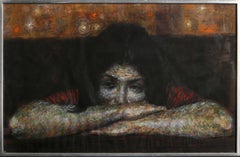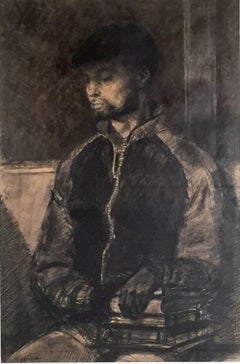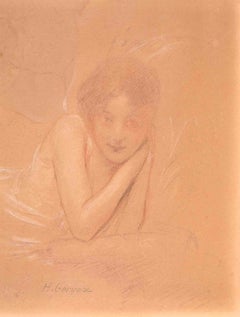Joseph Hirsch Portrait Drawings and Watercolors
American, 1910-1981
Joseph Hirsch was a member of the American Academy-Institute of Arts and Letters and a well-known realistic artist who came to national attention as a muralist for the Federal Works Progress Administration in the 1930's.
Of his own work, Mr. Hirsch wrote: ''I believe that some day the fabric of art will be threaded with morality, enabling us to distinguish evil from good. Today, this is unthinkable, in the delightful art world where, excepting censorship, anything goes. But anything goes does not accord with the more discriminating ethics of our civilized code which rules out what is socially destructive.''
Mr. Hirsch is represented in the Metropolitan Museum of Art, the Museum of Modern Art and the Whitney in New York; the National Gallery, the Corcoran and the Hirshhorn in Washington; the Boston Museum of Fine Arts, and in many major collections in the United States.
Joseph Hirsch was born on April 25, 1910 in Philadelphia, Pennsylvania. Hirsch studied at the Philadelphia Museum School, with Henry Hensche in Provincetown, Mass., and with George Luks in New York. In addition to formal study,
He participated in the Works Project Administration in the easel painting division, with occasional work in the mural division, where he painted murals in the Amalgamated Clothing Workers Building and the Municipal Court. During World War II, Joseph Hirsch took part in the war effort, as an artist war correspondent, recording significant battles and events.
He taught at the Chicago Art Institute, the American Art School, University of Utah, and had a significant tenure at the Art Students League in New York. He also won many awards, among them were a fellowship at the American Academy in Rome, the Walter Lippincott Prize, First Prize at the New York World's Fair (1939), the Guggenheim Foundation Fellowship (1942, 1943), and the Fulbright Fellowship (1949). In 1954 he was elected into the National Academy of Design as an Associate member and became a full Academician in 1958
Early in his career, Hirsch was introduced to the movement of Social Realism through George Luks, who was one of "The Eight". This group of painters, at the beginning of the century, chose to depict ordinary and everyday scenes. From this movement stemmed the Social Realism genre of the 1920s and 1930s. Social commentary was the backbone for the majority of Joseph Hirsch's paintings.
During World War II, Mr. Hirsch went to the South Pacific, North Africa and Italy as an artist-correspondent for the Navy, and his paintings and drawings are in the Museum of Military History. . In Major Collections. Hirsch's work is represented in the Metropolitan Museum of Art, the Museum of Modern Art and the Whitney in New York; the National Gallery, the Corcoran and the Hirshhorn in Washington; the Boston Museum of Fine Arts, and other collections in the USA. He was elected to membership in the National Institute of Arts and Letters in 1967. Hirsch died in New York, NY on September 21, 1981.to
1
1
Overall Width
to
Overall Height
to
2
1
1
1
1
1
2
2
1
1
1
1
1
1
1
21
189
72
60
51
1
2
Artist: Joseph Hirsch
Resting Girl, Modern Pastel on Paper by Joseph Hirsch
By Joseph Hirsch
Located in Long Island City, NY
Joseph Hirsch, American (1901 - 1981) - Resting Girl, Year: circa 1960, Medium: Pastel on Paper, signed in pencil top left, Size: 12.25 x 19.75 in. (31.12 x 50.17 cm), Frame Siz...
Category
1960s Modern Joseph Hirsch Portrait Drawings and Watercolors
Materials
Pastel
STUDENT
By Joseph Hirsch
Located in Portland, ME
Hirsch, Joseph (American, 1910-1980). STUDENT. Charcoal drawing on paper, not dated, but before 1980. Signed lower left, "J Hirsch." 17 1/2 x 11 1/4 inches (framed to 25 x 19 inches)...
Category
1970s American Realist Joseph Hirsch Portrait Drawings and Watercolors
Materials
Charcoal
$1,200
Related Items
Portrait of Young Woman - Drawing by Henri Gervex - Early 20th Century
By Henri Gervex
Located in Roma, IT
Portrait of Young Woman is an Original Pastel Drawing, realized in the 20th Century Henri Gervex (1852-1929).
The status of preservation Good.
The artwork is depicted skillfully th...
Category
Early 20th Century Modern Joseph Hirsch Portrait Drawings and Watercolors
Materials
Pastel
$818
H 14.97 in W 11.82 in D 0.08 in
Rare Modernist Hungarian Rabbi Pastel Drawing Gouache Painting Judaica Art Deco
By Hugó Scheiber
Located in Surfside, FL
Rabbi in the synagogue at prayer wearing tallit and tefillin.
Hugó Scheiber (born 29 September 1873 in Budapest – died there 7 March 1950) was a Hungarian modernist painter.
Hugo Scheiber was brought from Budapest to Vienna at the age of eight where his father worked as a sign painter for the Prater Theater. At fifteen, he returned with his family to Budapest and began working during the day to help support them and attending painting classes at the School of Design in the evening, where Henrik Papp was one of his teachers. He completed his studies in 1900. His work was at first in a post-Impressionistic style but from 1910 onward showed his increasing interest in German Expressionism and Futurism. This made it of little interest to the conservative Hungarian art establishment.
However, in 1915 he met the great Italian avant-gardist Filippo Tommaso Marinetti and the two painters became close friends. Marinetti invited him to join the Futurist Movement. The uniquely modernist style that he developed was, however, closer to German Expressionism than to Futurism and eventually drifted toward an international art deco manner similar to Erté's. In 1919, he and his friend Béla Kádar held an exhibition at the Hevesy Salon in Vienna. It was a great success and at last caused the Budapest Art Museum to acquire some of Scheiber's drawings. Encouraged, Scheiber came back to live in Vienna in 1920.
A turning point in Scheiber's career came a year later, when Herwarth Walden, founder of Germany's leading avant-garde periodical, Der Sturm, and of the Sturm Gallery in Berlin, became interested in Scheiber's work. Scheiber moved to Berlin in 1922, and his paintings soon appeared regularly in Walden's magazine and elsewhere. Exhibitions of his work followed in London, Rome, La Paz, and New York.
Scheiber's move to Germany coincided with a significant exodus of Hungarian artists to Berlin, including Laszlo Moholy-Nagy and Sandor Bortnyik. There had been a major split in ideology among the Hungarian avant-garde. The Constructivist and leader of the Hungarian avantgarde, Lajos Kassák (painted by Hugó Scheiber in 1930) believed that art should relate to all the needs of contemporary humankind. Thus he refused to compromise the purity of his style to reflect the demands of either the ruling class or socialists and communists. The other camp believed that an artist should be a figurehead for social and political change.
The fall out and factions that resulted from this politicisation resulted in most of the Hungarian avant gardists leaving Vienna for Berlin. Hungarian émigrés made up one of the largest minority groups in the German capital and the influx of their painters had a significant effect on Hungarian and international art. Another turning point of Scheiber's career came in 1926, with the New York exhibition of the Société Anonyme, organized by Katherine Dreier. Scheiber and other important avant garde artists from more than twenty-three countries were represented. In 1933, Scheiber was invited by Marinetti to participate in the great meeting of the Futurists held in Rome in late April 1933, Mostra Nazionale d’Arte Futurista where he was received with great enthusiasm. Gradually, the Hungarian artists began to return home, particularly with the rise of Nazism in Germany. Kádar went back from Berlin in about 1932 and Scheiber followed in 1934.
He was then at the peak of his powers and had a special flair in depicting café and cabaret life in vivid colors, sturdily abstracted forms and spontaneous brush strokes. Scheiber depicted cosmopolitan modern life using stylized shapes and expressive colors. His preferred subjects were cabaret and street scenes, jazz musicians, flappers, and a series of self-portraits (usually with a cigar). his principal media being gouache and oil. He was a member of the prestigious New Society of Artists (KUT—Képzőművészek Új Társasága)and seems to have weathered Hungary's post–World War II transition to state-communism without difficulty. He continued to be well regarded, eventually even receiving the posthumous honor of having one of his images used for a Russian Soviet postage stamp (see image above). Hugó Scheiber died in Budapest in 1950.
Paintings by Hugó Scheiber form part of permanent museum collections in Budapest (Hungarian National Museum), Pecs (Jannus Pannonius Museum), Vienna, New York, Bern and elsewhere. His work has also been shown in many important exhibitions, including:
"The Nell Walden Collection," Kunsthaus Zürich (1945)
"Collection of the Société Anonyme," Yale University Art Gallery, New Haven, Connecticut (1950)
"Hugó Scheiber: A Commemorative Exhibition," Hungarian National Museum, Budapest (1964)
"Ungarische Avantgarde," Galleria del Levante, Munich (1971)
"Paris-Berlin 1900-1930," Centre Georges Pompidou, Paris (1978)
"L’Art en Hongrie, 1905-1920," Musée d’Art et l’Industrie, Saint-Etienne (1980)
"Ungarische Avantgarde in der Weimarer Republik," Marburg (1986)
"Modernizmus," Eresz & Maklary Gallery, Budapest (2006)
"Hugó Scheiber & Béla Kádár," Galerie le Minotaure, Paris and Tel Aviv (2007)
Hugó Scheiber's paintings continue to be regularly sold at Sotheby's, Christie's, Gillen's Arts (London), Papillon Gallery (Los Angeles) and other auction houses.
He was included in the exhibition The Art Of Modern Hungary 1931 and other exhibitions along with Vilmos Novak Aba, Count Julius Batthyany, Pal Bor, Bela Buky, Denes Csanky, Istvan Csok, Bela Czobel, Peter Di Gabor, Bela Ivanyi Grunwald, Baron Ferenc Hatvany, Lipot Herman, Odon Marffy, C. Pal Molnar...
Category
Early 20th Century Modern Joseph Hirsch Portrait Drawings and Watercolors
Materials
Paper, Charcoal, Pastel, Watercolor, Gouache
$5,500
H 15.75 in W 14.5 in
Mickey Mantle, Yankees, Original Pastel Drawing by Jack Lane
By Jack Lane
Located in Long Island City, NY
A pastel drawing of Mickey Mantle by Jack Lane from 1986. A classic sports illustration of the legendary Mickey Mantle of the New York Yankees at bat. Fr...
Category
1980s American Realist Joseph Hirsch Portrait Drawings and Watercolors
Materials
Paper, Pastel
Nude Young Woman Art Deco Modernist ink drawing
Located in Wilton Manors, FL
Beautiful original drawing by American artist, Albert Sway (b.1913).
Portrait of a young woman, ca. 1935.
Ink on paper, measuring 8.5 x 11 inches.
Signed lower right. Unframed...
Category
1930s American Realist Joseph Hirsch Portrait Drawings and Watercolors
Materials
Paper, Ink
Woman Laughing - Original Pastel by Michel Simonidy - 1920s
By Michel Simonidy
Located in Roma, IT
Woman laughing is an original artwork by Michel Simonidy.
Mixed media, pastel drawing, and tempera on paper.
Hand-signed by the artist on the lower right. Includes passepartout. St...
Category
1920s Modern Joseph Hirsch Portrait Drawings and Watercolors
Materials
Pastel
$296
H 20.08 in W 13.78 in D 0.04 in
Man looking into Window
By Everett Shinn
Located in Miami, FL
Original Magazine Illustration for a magazine like Harper's, Vanity Fair, Life, Look, and Judge
Shinn was an American realist painter and member of the Ashcan School. He also exhibited with the short-lived group known as "The Eight,"
Work is framed in an attractive gilt frame
Morris Weiss collection...
Category
1910s American Realist Joseph Hirsch Portrait Drawings and Watercolors
Materials
Acrylic Polymer, Gouache, Pencil, Watercolor
The Captain's Lady
By Stephen Scott Young
Located in Miami, FL
This meticulously rendered work depicts a three-quarter view of a young woman lost in deep introspection.
Inscribed on verso: " The Captain's Lady"
Leslie of ____________ St. ...
Category
1980s American Realist Joseph Hirsch Portrait Drawings and Watercolors
Materials
Watercolor, Board
The Captain's Lady. style of Andrew Wyeth
By Stephen Scott Young
Located in Miami, FL
This meticulously rendered work depicts a three-quarter view of a young woman lost in deep introspection.
Inscribed on verso: " The Captain's Lady"
Leslie of ____________ St. ...
Category
1980s American Realist Joseph Hirsch Portrait Drawings and Watercolors
Materials
Watercolor
$49,600 Sale Price
20% Off
H 15.5 in W 14.5 in
Portrait of Christ - Original Drawing - Early 20th Century
Located in Roma, IT
Portrait of Christ is an original artwork realized by the Unknown Artist in the early 20th century.
Original colored pencil drawing on ivory-colored paper, glued on colored cardboa...
Category
Early 20th Century Modern Joseph Hirsch Portrait Drawings and Watercolors
Materials
Pen, Pastel
$249 Sale Price
40% Off
H 8.27 in W 4.93 in D 0.04 in
Country Life
By Stuart Davis
Located in Miami, FL
Early work when Stuart Davis was an illustrator.
Christie's, New York
Catalogue Raisonné
Category
1920s American Realist Joseph Hirsch Portrait Drawings and Watercolors
Materials
India Ink, Pencil
The Envy - Drawing - Early 20th Century
Located in Roma, IT
The Envy is an original drawing in Ink, Watercolor, and pastel by an anonymous artist in the first half of the 20th Century.
Good conditions.
The artwork is depicted through strong...
Category
Early 20th Century Modern Joseph Hirsch Portrait Drawings and Watercolors
Materials
Pastel, Ink, Watercolor
Canray and BoisSec (figurative drawing, Creole musicians, rural, fiddle player)
By Susan Kiefer
Located in Kansas City, MO
Susan Kiefer
Canray and BoisSec
Pastel on paper
Year: 2004
Size: 19x25in
COA provided
Ref.: 924802-1664
Framed pastel portrait of beloved Creole musicians Canray Fontenot and BoisSe...
Category
Early 2000s Modern Joseph Hirsch Portrait Drawings and Watercolors
Materials
Paper, Pastel
$1,222 Sale Price
38% Off
H 19 in W 24 in D 0.35 in
Joseph Hirsch portrait drawings and watercolors for sale on 1stDibs.
Find a wide variety of authentic Joseph Hirsch portrait drawings and watercolors available for sale on 1stDibs. You can also browse by medium to find art by Joseph Hirsch in charcoal and more. Not every interior allows for large Joseph Hirsch portrait drawings and watercolors, so small editions measuring 24 inches across are available. Customers who are interested in this artist might also find the work of Thomas Strickland, Joseph Yeager, and Dina Brodsky. Joseph Hirsch portrait drawings and watercolors prices can differ depending upon medium, time period and other attributes. On 1stDibs, the price for these items starts at $1,200 and tops out at $1,200, while the average work can sell for $1,200.



